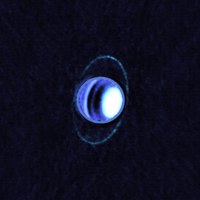The Solar System at Millimeter Wavelengths: Uranus
 The narrow main rings of Uranus are composed of almost exclusively centimeter- to meter-sized particles, with a very small or nonexistent dust component; however, the filling factor, composition, thickness, mass, and detailed particle size distribution of these rings remain poorly constrained. Using millimeter (1.3–3.1 mm) imaging with ALMA and mid-infrared (18.7 μm) imaging from the Very Large Telescope, Molter et al. observed the thermal component of the Uranian ring system for the first time. The ε ring is detected strongly and can be seen by eye in the images; the other main rings are visible in a radial (azimuthally averaged) profile at millimeter wavelengths. A simple thermal model similar to the Near-Earth Asteroid Thermal Model is applied to the ε ring to determine a ring particle temperature of 77.3 ± 1.8 K. The observed temperature is higher than expected for fast-rotating ring particles viewed at our observing geometry, meaning that the data favor a model in which the thermal inertia of the ring particles is low and/or their rotation rate is slow. The ε ring displays a factor of 2–3 brightness difference between periapsis and apoapsis, with 49.1% ± 2.2% of sightlines through the ring striking a particle. These observations are consistent with optical and near-infrared reflected light observations, confirming the hypothesis that micron-sized dust is not present in the ring system.
The narrow main rings of Uranus are composed of almost exclusively centimeter- to meter-sized particles, with a very small or nonexistent dust component; however, the filling factor, composition, thickness, mass, and detailed particle size distribution of these rings remain poorly constrained. Using millimeter (1.3–3.1 mm) imaging with ALMA and mid-infrared (18.7 μm) imaging from the Very Large Telescope, Molter et al. observed the thermal component of the Uranian ring system for the first time. The ε ring is detected strongly and can be seen by eye in the images; the other main rings are visible in a radial (azimuthally averaged) profile at millimeter wavelengths. A simple thermal model similar to the Near-Earth Asteroid Thermal Model is applied to the ε ring to determine a ring particle temperature of 77.3 ± 1.8 K. The observed temperature is higher than expected for fast-rotating ring particles viewed at our observing geometry, meaning that the data favor a model in which the thermal inertia of the ring particles is low and/or their rotation rate is slow. The ε ring displays a factor of 2–3 brightness difference between periapsis and apoapsis, with 49.1% ± 2.2% of sightlines through the ring striking a particle. These observations are consistent with optical and near-infrared reflected light observations, confirming the hypothesis that micron-sized dust is not present in the ring system.
Image: A 250 GHz image of Uranus and its rings (Molter et al.).
Publication: Edward M. Molter (University of California, Berkeley) et al., Thermal Emission from the Uranian Ring System, Astronomical Journal, 158, 47 (July 2019).
NRAO Press Release: Planetary Rings of Uranus 'Glow' in Cold Light




Connect with NRAO